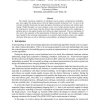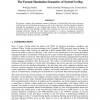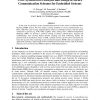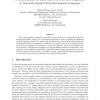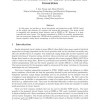132
click to vote
FDL
2004
IEEE
15 years 4 months ago
2004
IEEE
The steadily increasing complexity of embedded systems requires comprehensive methodoloat support the design process from the highest possible abstraction level. In most of the cu...
FDL
2004
IEEE
15 years 4 months ago
2004
IEEE
The article describes semi-symbolic methods for the analysis of control and signal processing systems, including static and dynamic uncertainties. This above mentioned semi-symbol...
FDL
2004
IEEE
15 years 4 months ago
2004
IEEE
We present a rigorous but transparent semantics definition of SystemVerilog that covers processes with blocking and non-blocking statements as well as their interaction with the s...
119
Voted
FDL
2004
IEEE
15 years 4 months ago
2004
IEEE
This paper presents a new approach to design embedded systems based on dynamic partial reconfigurable FPGAs. The approach is intended to allow designing of systems with runtime re...
119
click to vote
FDL
2004
IEEE
15 years 4 months ago
2004
IEEE
In this work we develop a secure communication protocol in the context of a Remote Meter Reading (RMR) System. We first analyze existing standards in secure communication (e.g. IP...
107
click to vote
FDL
2004
IEEE
15 years 4 months ago
2004
IEEE
In this paper, we are concerned with studying the semantic of the B modularity. We reuse the Harper-Lillibridge-Leroy (HLL) module system. This system implements an SML like module...
122
click to vote
FDL
2004
IEEE
15 years 4 months ago
2004
IEEE
With the increasing complexity of real-time control systems, it is important to have sufficient predictability support for a development approach in order to promote the likelihoo...
FDL
2004
IEEE
15 years 4 months ago
2004
IEEE
In this paper, we introduce a layout description and generation model, GBLD, based on the notions and elements of L-systems and context-free grammars. Our layout model is compatib...
145
Voted
FDL
2004
IEEE
15 years 4 months ago
2004
IEEE
System-on-Chip (SOC) and other complex distributed hardware/software systems contain heterogeneous components such as DSPs, micro-controllers, application specific logic etc., whi...
130
click to vote
FDL
2004
IEEE
15 years 4 months ago
2004
IEEE
This paper proposes a formal verification methodology which is smoothly integrated with component-based system-level design, using a divide and conquer approach. The methodology a...
